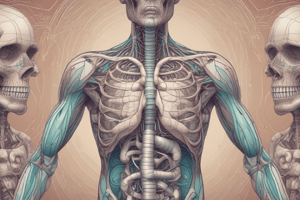Podcast
Questions and Answers
What is the main function of the respiratory system?
What is the main function of the respiratory system?
- Filtering air from dust and particles
- Supplying oxygen and removing carbon dioxide (correct)
- Regulating body temperature
- Digesting food in the body
Dalton's Law states that the total pressure of a gas mixture is the sum of the partial pressures of each gas present.
Dalton's Law states that the total pressure of a gas mixture is the sum of the partial pressures of each gas present.
True (A)
What are the three forms in which carbon dioxide is transported in the blood?
What are the three forms in which carbon dioxide is transported in the blood?
Dissolved in plasma, carried as bicarbonate, or as carbamino compounds bound to proteins
The _ is responsible for generating a pressure gradient to facilitate airflow in the respiratory system.
The _ is responsible for generating a pressure gradient to facilitate airflow in the respiratory system.
Match the component of the lower respiratory tract with its description:
Match the component of the lower respiratory tract with its description:
Flashcards are hidden until you start studying
Study Notes
Respiratory System Overview
- The respiratory system consists of the upper and lower respiratory tracts.
- The system's main function is to supply oxygen to cells and remove carbon dioxide.
Upper Respiratory Tract
- Consists of the nose, pharynx, and larynx.
- Functions include filtering, warming, and humidifying inspired air.
Lower Respiratory Tract
- Comprises the trachea, bronchi, bronchioles, alveolar ducts, alveolar sacs, and lungs.
- Functions include facilitating gas exchange through the respiratory zone.
Conducting Zone
- Brings air into and out of the lungs.
- Regulates airflow through circular smooth muscle contraction (bronchodilation vs. bronchoconstriction).
- Goblet cells secrete mucus to trap dust and particles, and cilia and mucus act as an escalator to move trapped material towards the pharynx.
Respiratory Zone
- Lined with alveoli for gas exchange, starting with the respiratory bronchioles.
- Alveoli are lined with alveolar type I and type II pneumocytes.
- Type II pneumocytes secrete pulmonary surfactant, which reduces surface tension and prevents alveolar collapse.
Pulmonary Ventilation
- Airflow occurs through a pressure gradient between the atmosphere and alveoli.
- Intrapleural pressure (negative pressure) is generated by the elastic forces of the lung and chest wall.
Gas Exchange in the Lungs
- Governed by Dalton's Law and the concept of partial pressures.
- Oxygen diffuses into the blood, and carbon dioxide diffuses out.
Carbon Dioxide Transport
- Carbon dioxide is transported in the blood in three forms: dissolved in plasma, as bicarbonate ions, and bound to proteins as carbamino compounds.
Control of Breathing
- Breathing is controlled by the respiratory centers in the brain stem.
- The medulla oblongata has dorsal and ventral respiratory groups responsible for inspiration and expiration.
Additional Functions
- The respiratory system filters, warms, and humidifies inspired air, maintains acid-base balance, and plays a role in the conversion of angiotensin I to angiotensin II.
- The system's functions extend beyond gas exchange, contributing to overall homeostasis of the body.
Studying That Suits You
Use AI to generate personalized quizzes and flashcards to suit your learning preferences.



